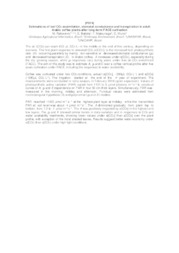Estimations of leaf CO2 assimilation, stomatal conductance and transpiration in adult Arabic coffee plants after long-term FACE cultivation.
Estimations of leaf CO2 assimilation, stomatal conductance and transpiration in adult Arabic coffee plants after long-term FACE cultivation.
Autoria: RAKOCEVIC, M.; BATISTA, E. R.; MATSUNAGA, F. T.; MUNIZ, G.
Resumo: The air [CO2] can reach 600 ?L CO2 L-1 in the middle or the end of this century, depending on scenario. The first plant response to elevated CO2 (e[CO2]) is the increased leaf photosynthetic rate (A) occurring parallelly by mainly non-sensitive or decreased stomatal conductance (gs) and decreased transpiration (E). In Arabic coffee, A increases under e[CO2], especially during the dry growing season, while gs responses vary during years under free-air-CO2-enrichment (FACE). The aim of this study was to estimate A, gs and E over a coffee vertical profile after five years cultivation under FACE, including the responses to water availability. Coffee was cultivated under two CO2 conditions, actual (a[CO2], ~390?L CO2 L-1) and e[CO2] (~590?L CO2 L-1). The irrigation started at the end of the 4th year of experiment. The measurements were conducted in rainy season, in February 2016 (grain expansion). Values of photosynthetic active radiation (PAR) varied from 1131 to 0 ?mol photons m?2 s?1 to construct curves of A, gs and E dependence on PAR in four 50 cm-thick layers. Simultaneously, PAR was measured in the morning, midday and afternoon. Punctual values were estimated from nonrectangular hyperbola (A) and polynomial (gs and E) models. PAR reached ~1400 ?mol m?2 s ?1 at the highest plant layer at midday, while the transmitted PAR at soil level was about 4 ?mol m?2 s?1. The A diminished gradually from plant top to bottom, from 7.2 to -1 ?mol m?2 s?1. The A was positively impacted by e[CO2] in the highest and low layers. The gs and E showed similar trends in daily variation and in responses to CO2 and water availability treatments, showing lower values under e[CO2] than a[CO2] over the plant profile, with exception of the most shaded leaves. Results suggest better water economy under e[CO2] than a[CO2] under high light conditions.
Ano de publicação: 2019
Tipo de publicação: Resumo em anais e proceedings
Unidade: Embrapa Meio Ambiente
Palavras-chave: Dought, Elevated CO2, Light microclimate, Plant vertical profile, Seca
Observações
1 - Por padrão são exibidas publicações dos últimos 20 anos. Para encontrar publicações mais antigas, configure o filtro ano de publicação, colocando o ano a partir do qual você deseja encontrar publicações. O filtro está na coluna da esquerda na busca acima.
2 - Para ler algumas publicações da Embrapa (apenas as que estão em formato ePub), é necessário ter, no celular ou computador, um desses softwares gratuitos. Sistemas Android: Google Play Livros; IOS: iBooks; Windows e Linux: software Calibre.
Acesse outras publicações
Acesse a Base de Dados da Pesquisa Agropecuária (BDPA) para consultar o acervo completo das bibliotecas da Embrapa.

